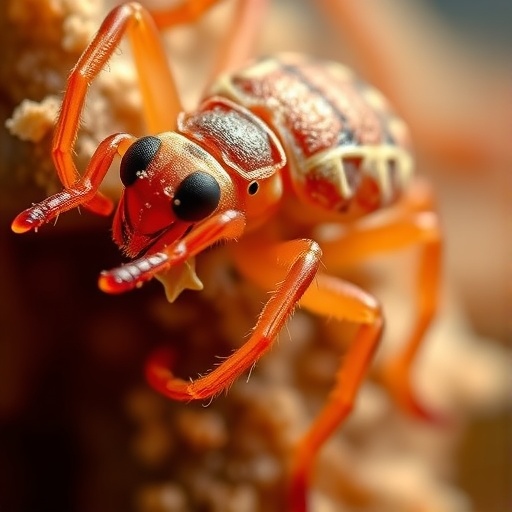A recently published article in Environmental Science and Pollution Research investigates the toxicity of two widely-used pesticides, λ-cyhalothrin and fenpyroximate, on a specific bee species known as Nannotrigona testaceicornis. This research is timely as it sheds light on the impacts of pesticides not only on target pest species but also on non-target organisms that play crucial roles in ecological health and agricultural productivity.
The study highlights a pressing concern regarding the effects of chemical inputs in agriculture, particularly on pollinators. As agriculture continues to rely heavily on chemical pesticides, understanding their broader ecological impacts is essential. Pollinators are vital for the reproduction of many plants, including crops that humans rely on for food. Thus, the findings from this research hold significant implications, especially given the global decline in bee populations and the potential risks posed to food security.
λ-Cyhalothrin is a synthetic pyrethroid insecticide commonly employed in agricultural settings to control a range of pests. Its mode of action is designed to disrupt the normal function of the insect nervous system, leading to paralysis and death of the targeted pests. However, this pesticide can have unintended consequences on non-target species, including beneficial insects like bees. Similarly, fenpyroximate is another pesticide known for its acaricidal properties, targeting mites while often affecting other beneficial arthropods. The research explores how these substances affect the behavior and survival rates of Nannotrigona testaceicornis, revealing critical insights into the risks these chemicals pose.
Researchers conducted toxicological assessments to determine the effects of both pesticides on Nannotrigona testaceicornis. This involved exposing bees to varying concentrations of the substances to assess lethality and sub-lethal effects. The findings indicated that exposure to λ-cyhalothrin resulted in significant mortality rates among the bees, particularly at higher concentrations. In contrast, fenpyroximate also posed risks, albeit with different mortality thresholds and behavioral impacts. These results underscore the need for more nuanced risk assessments and regulatory evaluations to protect these essential pollinators.
One of the notable concerns raised in the study is the potential for combined exposure to multiple pesticides. In real-world agricultural settings, pollinators are often exposed to a cocktail of chemicals, and the cumulative effects can be more severe than those observed with single exposures. Understanding the interactions between these different substances is essential for developing comprehensive mitigation strategies that safeguard pollinator populations.
The research also touches upon the behavioral changes induced by pesticide exposure. In addition to mortality rates, the study assessed how the pesticides affected foraging behavior and navigation of Nannotrigona testaceicornis. Such sub-lethal effects can lead to reduced efficiency in pollination and thus negatively impact plant reproduction and crop yields. These behavioral alterations highlight the complexity of pesticide impacts and emphasize the importance of studying ecological consequences beyond mere mortality.
Furthermore, the implications of these findings extend beyond Nannotrigona testaceicornis. They raise alarm bells for numerous other pollinator species that may be similarly affected by pesticide exposure. This is particularly concerning given the ecological interdependencies among species in a shared habitat. The loss of one pollinator can create cascading effects that compromise the health of entire ecosystems.
Agricultural practices must incorporate sustainable strategies that minimize reliance on harmful chemicals. Integrated pest management (IPM) approaches could be key to balancing pest control with conservation of beneficial species. By focusing on ecosystem health and biodiversity, farmers can mitigate the risks associated with pesticide use while maintaining crop yields and pest control effectiveness.
As anticipation builds for regulatory responses to these findings, the research advocates for the reassessment of pesticide safety evaluations. It calls for tighter restrictions on the use of harmful chemicals, particularly in regions where pollinator populations are already in decline. These changes could provide a framework to enhance pollinator health and improve overall agricultural sustainability.
In addition to influencing policy, this research encourages further studies into the long-term effects of pesticides on non-target insects. It also underscores the need for public awareness regarding the choices we make and their impacts on the environment. As consumers increasingly demand eco-friendly products, it becomes even more critical for stakeholders in agriculture to understand and implement safer practices that protect biodiversity.
Overall, this groundbreaking research illuminates the urgent need for change within agricultural paradigms. The continued use of harmful pesticides poses significant and potentially irreversible threats to pollinator species essential for biodiversity and food production. As the scientific community works to understand these complex relationships, the findings from this study will serve as a critical stepping stone toward fostering a more sustainable agricultural future.
The ongoing discourse surrounding pesticide regulation and its implications for environmental health is a pressing concern that necessitates immediateaction. As highlighted by the findings on Nannotrigona testaceicornis, preserving pollinator health is fundamentally linked to our own wellbeing, and proactive steps must be taken to ensure the vitality of these crucial species on which we depend.
Subject of Research: Toxicity of λ-cyhalothrin and fenpyroximate on Nannotrigona testaceicornis.
Article Title: Toxicity of λ-cyhalothrin and fenpyroximate on Nannotrigona testaceicornis.
Article References: Rebouças, J.S., dos Santos, J.A., Caldas, M.J.M. et al. Toxicity of λ-cyhalothrin and fenpyroximate on Nannotrigona testaceicornis. Environ Sci Pollut Res (2025). https://doi.org/10.1007/s11356-025-37169-7
Image Credits: AI Generated
DOI: https://doi.org/10.1007/s11356-025-37169-7
Keywords: λ-cyhalothrin, fenpyroximate, Nannotrigona testaceicornis, toxicity, pesticides, pollinators, ecological health.




